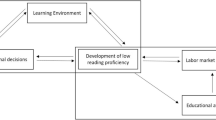Abstract
While the English literacy outcomes of Aboriginal children are constantly measured and debated, attention falls away once they leave school, leading to limited data on English literacy rates among Australia’s Aboriginal adults. This paper reports on an investigation into the prevalence of low literacy in adults in eight Aboriginal communities in NSW, Australia, drawing on both self-report data from household surveys and objective professional assessments using the Australian Core Skills Framework (ACSF). The research was conducted in partnership with a national Aboriginal organisation as part of a longitudinal study of the impact of improved adult literacy on the social determinants of health and social wellbeing. Of the participants who were measured to have low or very low English-language literacy level using ACSF, 51% had completed Year 10 or higher. This casts serious doubt on the value of school completion data which is used, for example, in Close the Gap reporting, as an accurate predictor of adult literacy rates. Results further show that while self-reported low literacy was prevalent in the population studied, there was also a significant overestimation, with adults who have completed years 10–11 nearly 30 times more likely to overestimate compared to people who only complete primary school. Given the well-known associations between adult literacy and a range of other outcomes including income, employment and health, national adult literacy surveys such as the Program for International Assessment of Adult Competencies should aim to produce more comprehensive national, regional and local data on Aboriginal adult English literacy.
Similar content being viewed by others
References
ABS. (2013). Programme for the international assessment of adult competencies, Australia, 2011–2012. cat 4228.0. Canberra: Australian Bureau of Statistics.
ABS. (2017). 2016 Census of population and housing. Aboriginal and Torres Strait Islander peoples profile. Catalogue number 2002.0. Canberra: Australian Bureau of Statistics.
ACARA. (2018). National assessment program literacy and numeracy national report for 2018. Retrieved from https://nap.edu.au/docs/default-source/resources/2018-naplan-national-report.pdf?sfvrsn=2
Black, S., & Yasukawa, K. (2014). The literacy myth continues: Adapting Graff’s thesis to contemporary policy discourses on adult ‘foundation skills’ in Australia. Critical Studies in Education, 55(2), 213–228.
Boughton, B. (2009). Popular education for literacy & health development in Aboriginal Australia. Australian Journal of Indigenous Education, 38, 103–108.
Boughton, B., Chee, D. A., Beetson, J., Durnan, D., & Leblanch, J. C. (2013). An Aboriginal adult literacy campaign in Australia using Yes I Can. Literacy and Numeracy Studies, 21(1), 5–32.
Boughton, B., & Durnan, D. (2014). Cuba’s Yo, Sí Puedo. A global literacy movement? Postcolonial Directions in Education Special Issue: Adult Literacy and Adult Education, 3(2), 325–359.
Circelli, M., Gillis, S., Dulhunty, M., Wu, M., & Calvitto, L. (2013). Does 1 = 1? Mapping measures of adult literacy and numeracy. Leabrook: NCVER.
Cohen, J. (1960). A coefficient of agreement for nominal scales. Educational and Psychological Measurement, 20(1), 37–46.
de Leeuw, E. (2012). The political ecosystem of health literacies. Health Promotion International, 27(1), 1–4. https://doi.org/10.1093/heapro/das001.
Department of the Prime Minister and Cabinet. (2019). Closing the gap report 2019. Department of the Prime Minister and Cabinet: Canberra.
DET (Department of Education & Training). (2012). Australian core skills framework. Retrieved from https://docs.employment.gov.au/documents/australian-core-skills-framework.
Kral, I., & Schwab, R. G. (2003). The realities of Aboriginal adult literacy acquisition and practice: Implications for capacity development in remote communities. Canberra: Centre for Aboriginal Economic Policy Research.
Lee, P. (1999). Why literacy matters: Links between reading ability and health. Archives of Opthalmology, 117(1), 100–104. https://doi.org/10.1001/archopht.117.1.100.
Lowe, K., Harrison, N., Tennent, C., Guenther, J., Vass, G., & Moodie, N. (2019). Factors affecting the development of school and Indigenous community engagement: A systematic review. The Australian Educational Researcher. https://doi.org/10.1007/s13384-019-00314-6.
McLennan, W. (1997). Aspects of literacy: Assessed skill levels Australia 1996. ABS Catalogue No. 4228.0 Canberra: Australian Bureau of Statistics.
Ratcliffe, R., & Boughton, B. (2019). The relationship between low adult literacy levels and Aboriginal family and community engagement in educational decision making. Australian and International Journal of Rural Education, 29(1), 1–16.
Reder, S., & Bynner, J. (2008). The need for longitudinal studies in adult literacy and numeracy education. In S. Reder & J. Bynner (Eds.), Tracking adult literacy and numeracy skills: Findings from longitudinal research (pp. 1–23). New York: Taylor and Francis.
SCOTESE (Council of Australian Governments Standing Council on Tertiary Education Skills and Employment) (2012). National foundation skills strategy for adults. Brisbane: SCOTESE.
Shalley, F., & Stewart, A. (2017). A statistical overview: Aboriginal adult language, literacy and numeracy in the Northern Territory. Darwin: Whole of Community Engagement Initiative, Office of the PVC of Indigenous Leadership, Charles Darwin University.
St. Clair, R. (2012). The limits of levels: Understanding the International Adult Literacy Surveys (IALS). International Review of Education, 58(6), 759–776. https://doi.org/10.1007/s11159-013-9330-z.
Tout, D., & Mendelovits, J. (2013). Questioning the standards of literacy and numeracy. 14 Oct, Australian Council for Educational Research (ACER). https://rd.acer.org/article/questioning-the-standards-of-literacy-and-numeracy
Weiss, B., Mays, M., Martz, W., Castro, K., DeWalt, D., Pignone, M., et al. (2005). Quick assessment of literacy in primary care: The newest vital sign. Annals of Family Medicine, 3(6), 514–522. https://doi.org/10.1370/afm.405.
Wilson, F. (1995). Measuring patients’ ability to read and comprehend: A first step in patient education. Nurse Connections, 8, 17–25.
Funding
Funding was supported by Australian Research Council Linkage Program (Grant No. LP160100257).
Author information
Authors and Affiliations
Corresponding author
Additional information
Publisher's Note
Springer Nature remains neutral with regard to jurisdictional claims in published maps and institutional affiliations.
The authors use the term ‘Aboriginal’ and ‘Aboriginal peoples’ to refer to the participants in this study. This term has been used in preference to ‘Aboriginal and Torres Strait Islander/s’ as our data come from New South Wales and there are no Torres Strait islander participants in our study. Furthermore, due to the widespread movement of peoples through colonisation, multiple language groups are represented in our sample and so we cannot refer to specific language groups.
Rights and permissions
About this article
Cite this article
Lin, S., Williamson, F., Beetson, J. et al. Quantifying low English literacy in Australian Aboriginal communities: a correlational study. Aust. Educ. Res. 48, 267–280 (2021). https://doi.org/10.1007/s13384-020-00388-7
Received:
Accepted:
Published:
Issue Date:
DOI: https://doi.org/10.1007/s13384-020-00388-7




